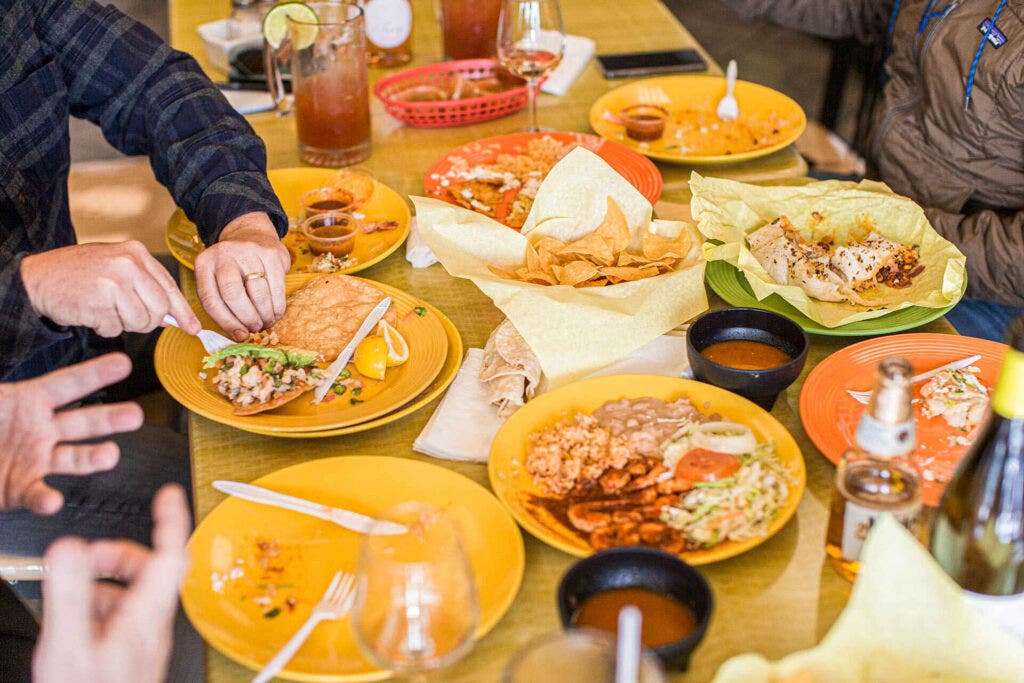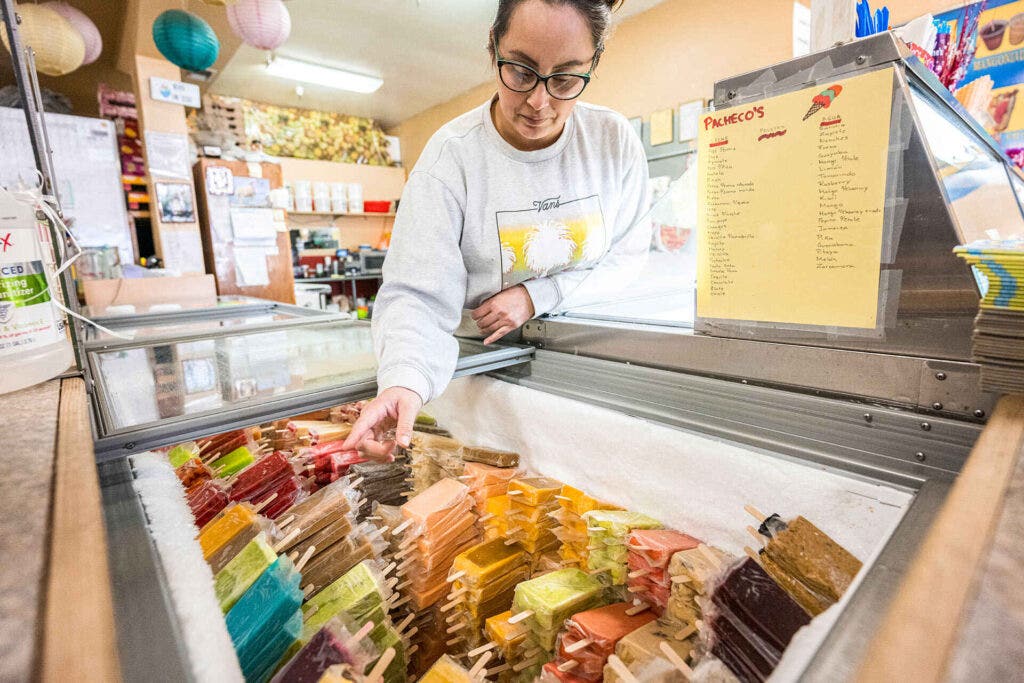Just as in Burgundy, Napa and other prominent wine regions of the world, California’s Salinas Valley is a patchwork of vineyards that spreads from the lowlands to the mountainsides, with a handful of small towns running down its spine. These are home to dozens of restaurants that nourish the wine industry’s many players, serving vineyard crews, winemakers and vintners alike from pre-dawn until far past dusk.
But instead of escargot, cassoulet and coq au vin, these establishments serve enchiladas, aguachiles and carnitas tacos, trading white tablecloths and mimosas for paper napkins, sides of salsa and micheladas. Mexican food rules the Salinas Valley, which, even compared to the rest of California, is home to a tremendous amount of these restaurants. About 50 Mexican eateries stretch from King City’s Broadway Street on the southern flanks to the strip malls of Gonzales about 30 miles north, and that’s not counting Salinas proper, a city even farther north that’s home to more than 160,000 people, 80% of whom are of Hispanic heritage.
This culinary concentration runs counter to the prevailing wine industry wisdom that there’s nowhere to eat in the Salinas Valley. To help me explore these establishments, I invited our magazine’s food editor, Nils Bernstein, who lives in Mexico, to join me for three days of indulgence at Greenfield cafes, Soledad taquerias and many more spots in between, on the recommendations of winemakers rooted in the region.

While Mexican cuisine may not be your stereotypical typical wine country fare, it’s just as delicious, creative and wine-friendly as everything else. It’s also considerably less expensive, especially without the corkage fees that rule other regions. So strap on that seat belt and come along for the ride—just remember that the other complaint about there being nowhere to stay in the Salinas Valley remains stubbornly true. Plan accordingly.
Nils: My first impression is that there’s something nicely full-circle that these towns are majority Mexican and Mexican-American, given that it was Mexico until the U.S. took it in 1848. Not that there’s equity of opportunity, but at least it’s good to see that the Mexican restaurants are family-owned and that the landowners and winery bigwigs live and eat alongside the vineyard and agricultural workers.
I’ve lived in Mexico part-time for over 20 years and roamed the country studying the cuisines for longer, and it’s almost like a distinct cuisine in Salinas Valley. The restaurants vary from seafood to diners to taquerías, but most are a blend of Norteño cuisine, Tex- (or Cal-) Mex offering a kind of pan-Mexican range of dishes.
There are certain dishes common to almost all the restaurants here that you wouldn’t necessarily see in the same place in Mexico: Camarones a la diabla (shrimp in a very spicy red chile sauce), caldo siete mares (a fish stew), chile verde and colorado (meat braised in green and red chile sauces), big sopes, even bigger burritos, tacos of lengua (beef tongue) and cabeza (beef head), and almost everything served combo-plate style with rice and beans.

Digging In
Matt: Our journey begins in a prominent corner in King City at Tacos La Potranca de Jalisco, where we scarf down tacos of cabeza, lengua and al pastor on the small picnic bench outside. This sort of streamlined taco shop is the lifeblood for many California communities, but it’s also the perfect place to observe just how pervasive Mexican cuisine and culture is here.
Within a one-minute walk are a panaderia (bakery), tortilleria (tortilla factory), carniceria (butcher shop), two more taquerias, a Michoacan-inspired paleteria (ice cream shop) and five sit-down restaurants advertising connections to Sinaloa, Nayarit and Guadalajara and one with a sign offering huaraches. (Across the street is The Cork & Plough, the only wine country-esque option around.) Next we snuggle into a booth at Mariscos El Camaron Estilo Nayarit, pairing zesty Pinot Gris by I. Brand & Family and Casitas de Bravo with aguachile verde and seafood cocktails.
Joining us was the latter brand’s owner, Fabian Bravo—who grew up 30 minutes away on Chardonnay Lane in Gonzalez—and Miguel Lepe, a Salinas son whose parents immigrated from Mexico in 1972. Over pickled pork skins and chile relleno at La Fogata in Greenfield, we talked about how wine is merging a bit more with Mexican culture, although the integration remains slow. Our server, for instance, didn’t even consider charging us a corkage, but she was also very happy to take the bottles we didn’t finish.
Dinner that night was at La Plaza Bakery in King City, the newest outlet for this Salinas juggernaut that Jesse Rodriguez started in 1982 and grew to seven locations. “We feed the workers,” he explains as we forked into barbacoa, slurped caldo de camaron and sipped on Roar’s Pinot Noir. “Everything we make, I try to make it like my mom and my aunts did.”

Nils: A lot of places cite a regional connection, saying that it’s from Michoacán or Jalisco or Nayarit. But that has more to do with where the family is from, since we have yet to find a place that actually serves food specific to a single region. From talking to people at the restaurants, most have been here for at least a couple generations and some sadly aren’t even able to return to Mexico. Someone here told me that the first Mexican-owned restaurants started in the early 1980s and that it took a while for other entrepreneurs to reach financial independence—or, in some cases, the legal status required to get bank loans.
One funny twist is that everything is served with lemon wedges, presumably because this is a center of lemon production. In Mexico, lemons are far more expensive than limes and are considered a luxury item of sorts.
I was surprised how fresh the seafood dishes were until I remembered that it’s just an hour drive to Monterey Bay. Ceviches, aguachiles, shrimp dishes and even whole fried rockfish were surprisingly excellent almost across the board.
Matt: Many of the same basic items are on each menu. That’s not uncommon across California’s Mexican cuisine landscape, but there is increasingly specialization everywhere as Mexico’s culinary star ascends. I hear that’s happening in the city of Salinas, if not quite yet in these smaller towns.
But each establishment did serve something unique, often traditional dishes done in special ways. There was the puffed up sope at La Fogata in Greenfield that none of us had ever seen—sopes are usually flatter and more cake-like—and the use of smoky chili negro on a steak huarache at Taqueria Comidas Sabrosas in Soledad. And because we showed up at each place with varying types of wine, we found endless combinations of flavors that maybe had never been explored before.

Sipping, Swirling and Salsa
Nils: People often think of crisp white wines with Mexican food, for various reasons: an association with hot weather, a memory of eating Mexican food with crisp lagers or thinking that tannins in red wine clash with spicy food. But, seafood aside, I found the reds worked best. Most dishes aren’t that spicy unless you add salsa, and whether it’s tacos of braised beef and pork or meat stewed in deeply rich red chile sauces, the reds’ flavors and tannins always complement fatty meats and sauces.
Tasting wines at these restaurants reinforced how we need to come to pairings with an open mind. Red wines often show dried-chile notes that aren’t in the typical tasters’ memory banks. Even those can be separated into, for example, ancho versus guajillo versus pasilla notes. Drinking aguas frescas of jamaica (hibiscus) and tamarind alongside wines helped identify the same notes in rosés and lighter reds.
I was initially worried because most wines from the nearby Santa Lucia Highlands are Pinot Noir and Chardonnay. Pinots can get lost in the intensity of Mexican food, but those from SLH are intensely ripe, full of red berries, earth and spice but with balancing acidity. Chards don’t work when they veer too tropical, but the ones that show citrus, saline or stony minerality are terrific with tacos and seafood dishes.
Matt: Even aged wines held up to the Mexican food, like when photographer Nic Coury cracked a bottle of 2007 Pisoni Syrah over papas tacos, chilaquiles and a bacon-laden breakfast burrito at Linda Taqueria in Gonzales. Nils liked it best with the camarones de diablo, especially how the chocolate flavors and resolved tannins softened the spice in the dish. As vintner Scott Caraccioli put it, “It’s got enough to carry the conversation and not get lost.”

The citrusy, minerally Lucy Pico Blanco, a blend of Pinot Gris and Pinot Blanc that Mark Pisoni brought, worked much better with Linda’s ceviche and papas tacos dorados, which were mashed potatoes in a hard taco shell. So did our chavelas, the popular cocktail of cold beer, lime, tomato juice and spicy sauce in a frosty mug, rimmed with Tajín and a finger of poached shrimp.
Nils: Actually, some of the lesser-grown grapes were most exciting with the food. We tasted some amazing Cabernet Franc by Lepe Cellars that straight-up showed red-chile notes, aligning perfectly with the food. A Wrath Falangina and Scheid Albariño were refreshing but rich enough to pair with a surprising range of dishes. Rosé, like the Lucy rosé of Pinot Noir by the pioneering Pisoni family, shows the same balance of brightness and richness that the best Mexican food does.
Matt: Discovery really became the theme of our trip. Walking into the Pacheco Water Store—which primarily sells water and ice to the farms—to find a bustling ice cream and paleta shop was my favorite find of the trip.

“We process daily; we’re cutting up fruit at 4 a.m.,” explained Janet Pacheco, whose parents opened the store in 2010 after learning how to make these frozen treats from relatives in Mexico. “When it’s crazy, it’s crazy,” she said, as I sucked down a cucumber-chile popsicle. “We can make 1,000 paletas a day.”
It wasn’t just eye-opening for Nils and me. We were also introducing winemakers who’d lived and worked in the region for decades to new places, freeing them from their habitual routines. Paul Clifton of Hahn Wines joined us at Taqueria Comidas Sabrosas, a dimly lit hole-in-the-wall with a lucky frog statue on the counter. Their special dish, the super quesadilla de maiz, was a cheesy beast, layered in texture and flavor. Drinking Hahn GSM out of paper cups was the right call. A few bites in, Paul’s eyes lit up as he blurted out, “I think this is my new place.”
The rest of us couldn’t help but agree. Maybe we’ll see you next time.

Where We Ate
On the recommendations of Salinas Valley Winemakers
- Taqueria La Potranca, King City
- Mariscos El Camaron Estilo Nayarit, King City
- La Fogata, Greenfield
- El Tamalaso y Mas Bakery, Greenfield
- La Plaza Bakery, locations in every city in Salinas Valley
- Linda Taqueria, Gonzales
- Pacheco Water Store, Gonzales
- Taqueria Pacheco, Soledad
- Taqueria Comidas Sabrosas, Soledad
- Lalo’s Mexican Antojitos, Soledad

Winemakers Who Joined Us
(Or sent wines we paired)
- Ian Brand, I. Brand & Family Wines
- Fabian Bravo, Casitas de Bravo & The Brander Vineyard
- Scott Caraccioli, Caraccioli Cellars
- Paul Clifton, Hahn Wines
- Adam and Nick Franscioni, Roar Vineyards
- Ted Glennon, Vocal Vineyards
- Denis Hoey, Odonata Wines
- Russell Joyce, Joyce Vineyards
- Miguel Lepe, Lepe Vineyards
- Mark Pisoni, Pisoni Vineyards
- Sabrine Rodems, Scratch & Wrath Wines
- Heidi Scheid, Scheid Family Wines
- Kim Stemler, Monterey County Vintners
This article originally appeared in the June/July 2023 issue of Wine Enthusiast magazine. Click here to subscribe today!
Last Updated: June 6, 2023















